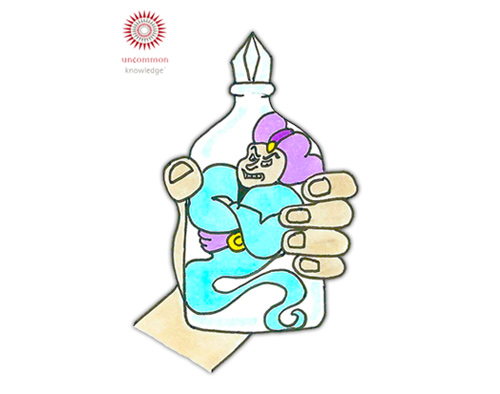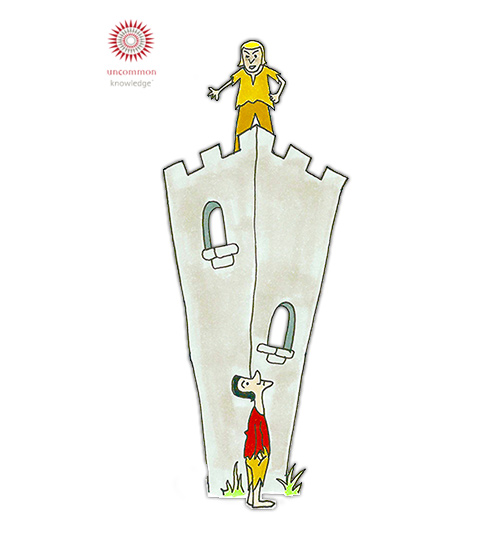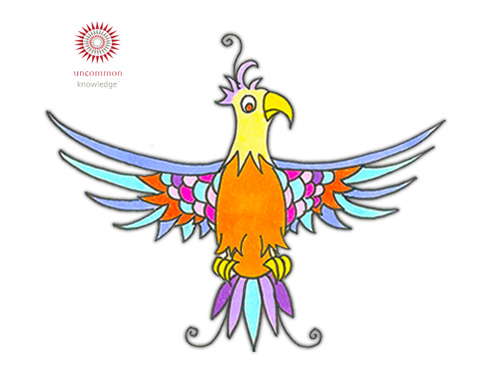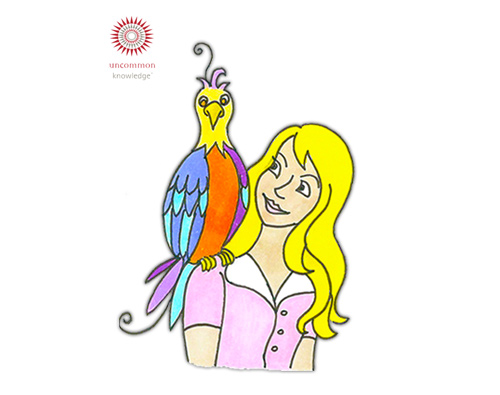
A well chosen story can reveal a wealth of insight for a struggling client
Article by Rob Parkinson, author of the Uncommon Knowledge Powerful Stories CD
Let’s start with a simple tale.
Ely has had quite a fight with Enoch. The two of them haven’t spoken for days when Ely sees his chum walking along on the opposite side of the road and decides to patch things up. “Is that you mate?” he calls out.
But Enoch is having none of it; he hasn’t forgiven Ely and he’s still raging. He sticks his nose in the air and says sulkily, “No!” Ely thinks for a moment and shouts back, “Well it ain’t me, neither!”
It’s a little story with a very big theme, but I’d guess anyone involved with therapy of any kind would scarcely need a storyteller to tell them that. It’s from a set of oral tales still more or less in currency, especially around the English West Midlands and particularly the English Black Country, where Ely and Enoch are supposed to live. (You can’t hear the regional accents on the page.)
It’s easy to see how much there can be in a story like this one. In a lot of conflict situations, people really are ‘not themselves’, and understanding that can be an important starting point.
As the 14th century Persian poet, mystic and fabulist Jalaluddin Rumi said, “A tale, however slight, illuminates truth.” It’s something I’ve seen again and again in my 20-plus years as a professional teller of tales.
One thing is for certain.
Mysterious forgotten voices
Working day after day with a huge variety of stories, telling them to equally varied audiences, leaves you with an enormous respect for the largely anonymous makers and transmitters of the tales that form the oral traditions of the world.
And I’m not talking only of short, illustrative anecdotes like the Ely and Enoch story, nor of tales of more obvious moral instruction, though by the same token I wouldn’t want to underestimate those.
If you have already come across the stories of the Mulla Nasrudin (also known as Hodja Nasreddin, or Goha to the Arabs) popular in the Middle East, or the many short Zen tales, you’ll already be aware how much a short, seemingly slight tale can ‘carry’. If not, I can thoroughly recommend them.
But traditional stories come in all shapes and sizes. There are, for example, myths and legends of all kinds, wonder tales, fairy tales, fables, tall tales, hero stories, trickster stories, ghost tales, teaching stories, oral histories and many more. Of course, the categories meld into each other; a tale of this or that historical figure turns up elsewhere as part of a mythical cycle or a fairy tale; one man’s fable becomes another’s joke.
The thing to understand about stories
People in ancient times travelled far more than is commonly thought. When they did, they took along their invisible luggage of tales which they shared along the road or by the campfire. In pre-literacy days, people perhaps had better listening skills, better memories and maybe even less need to be fettered by ‘authenticity’. In any case, somehow or other, stories not only stuck but were told and retold and, in the process, dressed themselves in local costume, becoming part of widely differing cultures.
Oral storytelling was very much part of life: people told stories in all sorts of contexts – at the loom, in the field, with needle or adze or brush in hand. And alongside the ordinary folk, professional tellers of tales of all kinds told their stories, from marketplace to palace.
So what was so attractive and important about stories?
It’s a simple question with a huge, ramifying answer that there’s not space to do justice to here. But basically our world is far more shaped by the stories we tell and repeat than we realize, and that’s as true in our 21st-century, media-dominated world as it was a thousand years ago.
Stories show life as it might be, should be, shouldn’t be, never could be. Basic social values, skills, and wisdoms all show up in stories, but so do all sorts of other things, on many different levels.
It’s no accident that the founders of religions have been storytellers. Christ had his parables, Mohammed his teaching stories, Buddha his Jataka Tales.
It’s also entirely natural that many of the first great books, the cornerstones of literary cultures across the world, have been collections of stories brought together from oral tradition – the Panchatantra from India, which became Kalila and Dimna in the Arab world; the Alif Layla wa Layla (Arabian Nights); the Decameron; the Fables of Aesop; and Homer’s Odyssey and Iliad to name but a few. And English literature more or less begins with Chaucer’s Tales of Canterbury, essentially a book of stories told on the road.
All this is very interesting and intriguing, but where’s the relevance?
Ancient patterns of wisdom
Why bother with old tales from old worlds when we have hundreds of thousands of new ones made to measure for today and available at the flick of a switch? Isn’t oral storytelling today a bit like verbal Morris dancing – very quaint and folksy no doubt, but hardly challenging and contemporary? Why give it a second thought, other than as a ‘heritage experience’?
One morning in the mid to late ’80s, a friend turned up at my door at 5.30 am looking wild and strange. Apparently the sky had been coming in through his head all night. It was an early episode of what was later diagnosed as schizophrenia, but it wasn’t my job to tell him that even if I’d had the background and training (which I hadn’t). All I could do was sit him down and tell him a story, which is why, I suppose, he might have chosen to come by: he liked listening to my tales.
A story for schizophrenia

I went for something you might think of as obvious, a version of the ‘genie in the bottle’ story from Arabian Nights. If you remember, the fisherman finds a bottle and opens it, but the genie inside turns out to be not the wish-giving kind at all – more your murderous bastard, in fact.
He allows the fisherman the chance to ask only one question, after which he’ll kill him. The fisherman elects to know how such an enormous spirit could possibly have fitted inside the bottle, and when this very powerful but fortunately stupid genie demonstrates by shrinking and hopping back inside, he corks it up again. He then has the option of throwing the bottle back into the sea, keeping it by him corked up or letting the genie (who now promises wishes and all sorts) out again.
In folklore (as in different ‘arrangements’ of Arabian Nights) there are all sorts of versions of what happens next and all sorts of treatments of the same fundamental plot motif of ‘the trapped being of power’. It might be worth mentioning (since these things sometimes get in the way) that, in different tellings from different cultures, the fisherman figure changes gender and class, time and place, while the genie becomes devil, demon, ghost and all sorts of other things.
But, I suppose, however the story is dressed and wherever or whenever it is told, there’s an essential element that communicates, that makes metaphorical sense, perhaps particularly to someone going through what my untimely visitor was going through.
Anyway, listening to the tale calmed him down at least – such is the power of storytelling. Afterwards he swore that it had made a huge amount of immediate and practical sense too, maybe partly because, on that occasion, I turned the tale into what is called a dilemma story – I left the ending open, and we talked about the fisherman’s options.
These stories that crop up over and over in different times and cultures are important, because they meet a real need and apply to universal human dilemmas and aspirations.
So what are the themes of this particular genie in a bottle motif?
Timeless themes of you and me
There are two themes I’d like to draw out. The first centres around the story itself and tales like it. As I’ve already suggested, it’s one of many so-called ‘universal’ tales – it crops up in many different cultures in different disguises. It’s a short example; longer tales are often made up of various shorter plots and motifs stitched together in different ways.
Many of the fairy tales we grew up with are examples. For instance, hundreds of variants of the Cinderella story have been recorded around the world. In 1893, Marian Roalfe Cox abstracted 345 (mostly European) variants in a study for the Folklore Society, hailed as the first ‘scientific’ investigation of a tale and its variants. Her list has been much augmented in the century since, with studies of Cinderella in other cultures.
The trouble with folklore study though, at least in its more old-fashioned orthodoxies (modern folklore study is different), is that it’s a bit like Victorian butterfly collecting. Specimens are caught, preserved, and ‘pin-stuck under glass’ as it were. A marvellous, colourful display, but you can’t always see that the specimens were once alive, much less imagine how they were alive.
Changing meaning
Traditional stories are often loaded with potent imagery; again, it’s not hard to see how this applies to the Cinderella story.
The most interesting and enduring tales cross cultures, moving easily between widely different mindsets not just because people happened to have them in their rucksacks and dumped them off by accident, but because they mean and always have meant something that transcends culture and time.
Whether or not they carry traces of this or that ancient civilization, way of thinking, or whatever, they can say important, useful, and resonant things about what it is to be human here and now. They offer solutions, strategies, and new chances at the same time as feeding the imagination and sense of fantasy. They are a rich seam to mine for anyone interested in human development.
But back to the story of the genie in a bottle, and my second ‘theme’. You could argue that it’s not very much of a story, especially summarized briefly in the way I’ve done above. Stripped back to the ‘bare bones’, it could well seem slight – amusing, maybe, but lacking the kind of depth you might expect from a ‘real’ story.
It’s very easy to apply the wrong kind of standard. We are used to an ‘urtext’ model of literature: there is one original and ideal model for the story somewhere, recorded in words or whatever. Performances may attempt to interpret that model, but don’t change it essentially.
But this kind of thinking doesn’t or shouldn’t apply to the oral tale, because it’s really a bird in flight, not a stuffed one. In other words, part of the meaning and sense of the story is situational. It’s what the teller and their listeners add to it that brings it to life. The sense my early-morning visitor and I made of the story was, in a way, unique to that occasion and time.
The storyteller’s art

When you bring a story out and tell it, perform it for an audience – even if that audience is made up of only one person – you spin it out and improvise on it. The way it develops on the day depends a lot on your interaction with your audience and how ‘right’ you can make it for the time and place.
Of course, if you are a professional like me, you draw on a knowledge of traditional ways of embellishing and extending tales as well as having a few tricks of your own up your sleeve. I’m a musician, a trained guitar and lute player in fact, and I also know my way around a range of unusual ancient and ethnic instruments, all of which can help to establish the right kind of mood for listening.
And of course, professional storyteller figures of many cultures (rawis, kathakars, griots et al.) have been bards and minstrels, probably because music (or even sensitively used raw sound) can enhance listening and imagining. On the other hand, I’ve seen storytelling combined very effectively with conjuring, juggling and even paper folding.
Now, what a professional does with a story in a situation that’s really about entertainment (or possibly even art) might seem very different from what a therapist or a counsellor, or, for that matter, an educator would do, but there have to be common threads.
Among these, I’d identify particularly the real need for empathy and respect between audience and teller, combined with improvisation that is related directly to improving communication and developing real attention, not there just as a frill.
I’d also rule out of any effective storytelling interaction any hint of the ham thespian or what I’d call (in a shorthand I think you might just understand) ‘getting off’ on a story. Insincerity of any kind is not usually helpful to human relationships.
The thing is that any kind of storytelling situation is, at least potentially, alive. There are discoveries to be made for both teller and listener. In a way, the distinction people make between ‘telling your own story’ and telling a tale that comes from tradition is false, because we’re always telling our own story.
As poet James Berry once wrote when signing his book of Anansi stories for me, “A storyteller wants to be all his characters – or knows he’s all of them.”
The Enchanting Bird
Anyway, here, in brief summary form (I know several long versions that can take up to an hour to tell), is the main part of one of my own all-time favourite fairy stories. For publishing purposes, the copyright of this ‘arrangement’ of the traditional plot is mine, so at least consult me on sources if you want to reproduce it in a text.
But you’re very welcome to take it off the page, adventure with it, and make as much oral use of it as you like, because I reckon there’s a fair amount in there, in terms of both plot and incidental motifs. And, unlike Ely and Enoch, that is me talking.
The Enchanting Bird, Part 1

Two brothers and a sister set off in turn to find the Enchanting Bird of Truth. They are orphans, left in the woods as babies and brought up by charcoal burners, so now they want to find out about their origins.
Well, the oldest brother sets out, leaving a knife for his siblings to watch over. If it rusts, he’s in danger; if blood appears on it, he is dead.
He stops in a city and finds out from a storyteller telling tales in the marketplace that there is a mountain 21 days’ march away. On this mountain, the storyteller says, the Enchanting Bird of Truth perches. To reach it, he must follow the ‘heart road’ and not leave it, though he may look to the right or the left at wonders he may see as he passes.
When he reaches the shadow of the mountain, however, he must look straight ahead and up towards the bird and not be distracted. The huge white bird will look back at him, fixing him with a fierce gaze. At its feet on the mountain peak will be two piles of dust, one white and one blue.
If he looks away, the bird will fly up into the air and drop the blue dust on him, and he will turn to a blue stone on the mountainside, where he will stay forever unless someone rescues him.
But if he manages to get all the way to the top without being distracted, then the bird will drop white dust on him and he will have the truth, and the bird itself will turn into a white sparrow and perch on his shoulder.
This is what the storyteller tells him, and he listens, but he doesn’t listen to the story the storyteller tells that day in the marketplace.
He’s too busy preparing and then setting off on the heart road, which he follows, seeing to his amazement to the right and the left of that path enchanted gardens, flying palaces, dragons, giants and all kinds of strange things. He stays on the road and reaches the mountain, but as soon as he steps into the shadow and begins to climb, he hears voices calling out to him all around, begging him to turn this way or that.
What’s more, the bird seems huge and its eyes seem to burn him. In the end, he’s unable to resist turning his head as a voice offers a shortcut. Instantly, the bird flies up and drops the blue dust and he turns to a blue stone.
The Enchanting Bird, Part 2

Back in the woods, rust appears on the knife, so the second brother sets off, leaving behind a rosary of pearls. If the pearls stick, then he’s in danger; if they form a leaden lump, then he’s dead. Of course, he finds the same storyteller, hears about the same Bird of Truth, and sets out along the heart road.
Like his brother, he doesn’t bother to listen to the storyteller’s story. Like his brother, he sees wonders of all kinds, reaches the mountain, and looks straight ahead as he climbs. Like his brother, he hears all kinds of voices calling him here and there, one of which is his own brother’s voice. Like his brother, he can’t resist turning, and he too becomes a blue stone.
So then it’s up to the girl. Finding that the pearls are sticking, she sets out and finds the same storyteller who tells her about the bird on the mountain. Off she goes, but not before she has listened well to, marked, and inwardly digested the storyteller’s story.
She travels the heart road, sees incredible wonders, reaches the mountain and walks right to the top, where the bird flies into the air, drops white dust on her and perches on her shoulder. Now she has the truth: she is a princess cheated out of her inheritance by wicked aunts who imprisoned her mother. Her brothers, whom she now rescues along with a thousand other young men who turned to stone on the mountainside, are princes. They set off to make wrongs into rights, and what happens next is, more or less, another story.
What about the story the storyteller told in the marketplace, you may ask. Well, it’s complicated, and if I see you some time, I might tell it to you in full. But the main thing to understand is the little trick it suggested to the girl. When she climbed the mountain, the voices were all around – but she didn’t hear them. She’d stuffed her ears with cotton wool, you see.
It just goes to show, however many lies they might tell you along the way, storytellers are only doing it so you can get to the truth.
© Rob Parkinson 2001
N.B. The above article first appeared in the Systemic Therapy magazine, Context, in 2001. It has been adapted slightly here.
Rob Parkinson has been a professional storyteller since 1984 and has told his tales in many hundreds of schools as well as in arts centres, pubs and theatres; on TV; and even in shacks in the Australian outback. He is a former Chair of the Society for Storytelling and has written many articles on storytelling. Rob also practises as a therapist, using stories extensively in his work.








